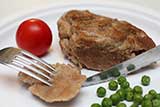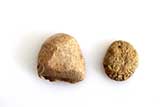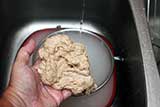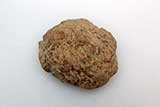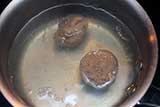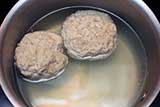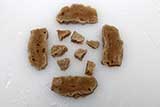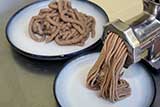Meats and Sausages
Wheat Gluten
Wheat gluten also called seitan, wheat meat, gluten meat, or simply gluten, is made from gluten, the main protein of wheat. It is made by kneading wheat flour dough in water until all the starch particles have been removed, leaving the sticky, insoluble gluten paste which is then cooked before being eaten. Wheat gluten is not a good choice for celiacs and gluten-sensitive individuals, so it is less popular than tofu, however, it displays the superior ability to take on the texture and flavor of meat. It can be thinly sliced on vegetarian sandwiches, added to sauces, or used as ta opping on vegetarian pizza. Wheat gluten has a chewy texture that resembles meat more than other substitutes.
Making Wheat Gluten
The procedure is simple; the dough is made by combining whole wheat flour with water, then it is kneaded under to rinse away the starch. What is left is a high-protein gluten dough. When the gluten dough is steamed, baked, or boiled, it becomes chewy with a meat-like texture.
Making Wheat Gluten-Traditional Method
Materials: whole wheat flour, water.
Place flour in a bowl. Add 50% water and start mixing, more water will be needed. For 1 lb (453 g) flour you may need around 1 cup and 1 oz of water (280 ml.
Break the dough into 2 inch diameter balls (it will be difficult to knead the whole piece of dough). Knead each ball for about 5 minutes underwater. This will force starch out and the water will become milky. Empty and refill the bowl periodically until the water stays clear. The dough will shrink to less than half its original size and get stretchy.
Making wheat gluten using shortcut method
Materials: vital wheat gluten, water.
Place vital wheat gluten flour in a bowl, add some water, and mix. Start kneading adding water only if needed. Separate the gluten dough into smaller chunks and flatten them. Bring water or vegetable stock to a boil. The dough will expand so have enough liquid in a pot. Simmer covered for 2 hours. Remove from liquid and allow to cool. It is done when firm and expanded.
Discussion
- Whole wheat flour produces the best gluten with meat like bite and texture.
- Mixing whole wheat with general-purpose flour has produced an acceptable product.
- General-purpose flour produces very soft gluten.
- Using vital wheat gluten flour speeds up the process of making gluten, however, the product has a very rubbery texture that does not feel like meat at all. It is not suitable for grinding and its rubbery structure makes it a poor choice for sausages. This, however, does not diminish the exceptional value of vital wheat flour for general binding purposes.
- One pound of whole wheat flour will produce a little less than one pound of wheat gluten after cooking.
- Vegetable broth and flavorings can be added to the dough, but keep in mind that whole wheat flour is kneaded extensively under water to remove starch, so there will be a significant loss of broth and spices. However, gluten will acquire flavor when boiled in a spiced vegetable broth.
- Wheat gluten freezes well.
- Wheat gluten can be diced and added as show material to other vegetarian sausages.
Gluten Intolerance
All grains contain a protein known as gluten, but people with celiac disease and most other gluten allergies only react to gluten found in wheat, barley, and rye and products derived from those grains.
If you suspect that you react badly to gluten - with symptoms like diarrhea, upset stomach, abdominal pain, and bloating - get tested for celiac disease, all it takes is a blood test. If you have celiac disease and you eat gluten, the lining of your small intestine becomes inflamed and gets damaged, making it harder for your body to absorb nutrients. That can lead to malnutrition and weight loss. Many people do not have celiac disease but are very sensitive to ingesting gluten.
The common symptoms include gastrointestinal problems, joint pain, fatigue, and depression.
Murphy's Law states: " If it's not broken, don't fix it."
Thus, don't go on a gluten-free diet when there is no need for it. Let your body work the way it was designed to. Gluten-free diets do help people who are sensitive to gluten. There's a misconception that a gluten-free diet helps with other conditions or with weight loss. Whole grains are an important part of a healthy diet, and a gluten-free diet offers no health-related benefits for people who do not suffer from gluten intolerance.
Seitan
Seitan is flavored wheat gluten. Soy sauce is combined with vegetable stock and added with ginger and garlic during the kneading dough. Flavoring is limited only by your imagination. Then, the seitan is cooked in a combination of vegetable stock and soy sauce.
Seitan and wheat gluten keep well in the freezer. in a sealed container or zip lock bag so make a larger batch and freeze for later, thawing for an hour or two first before using.
Vegetarian sausage recipes are listed in the Sausage Recipe Index

